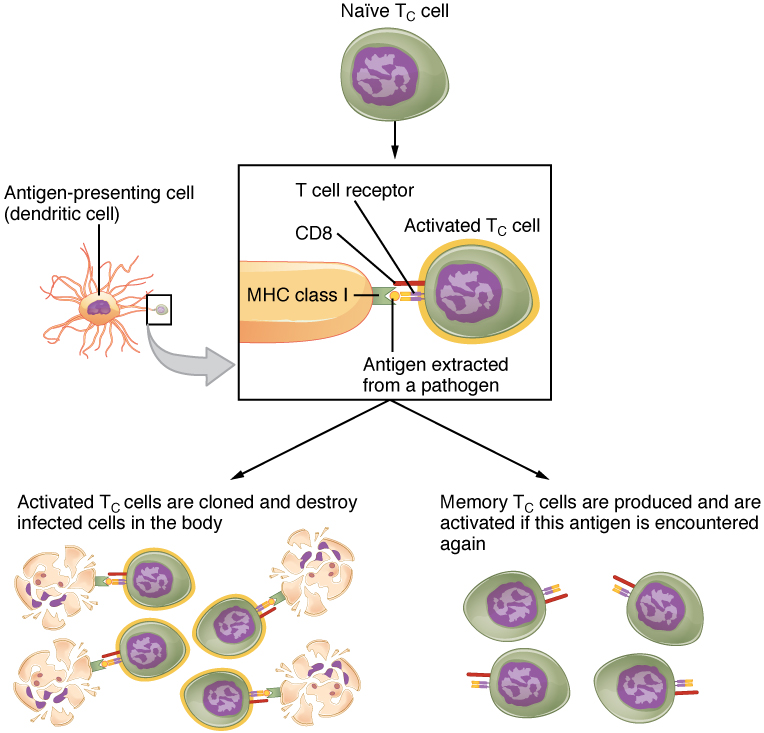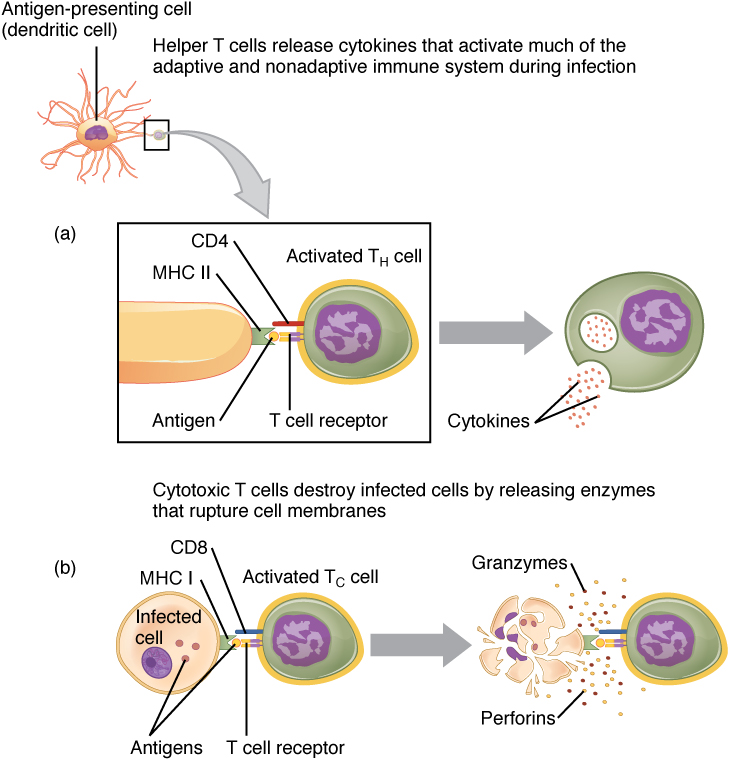| << Chapter < Page | Chapter >> Page > |
The primary cells that control the adaptive immune response are the lymphocytes, the T and B cells . T cells are particularly important, as they not only control a multitude of immune responses directly, but also control B cell immune responses in many cases. Thus, many of the decisions about how to attack a pathogen are made at the T cell level, so knowledge of their functional types is crucial to understanding the adaptive immune responses as a whole.
Mature T cells become activated by recognizing a foreign antigen "presented" by a major histocompatibility complex or MHC molecule and begin dividing rapidly by mitosis. This increase of T cells is called clonal expansion and is necessary to make the immune response strong enough to effectively control a pathogen. By the time this process is complete, the body will have large numbers of specific lymphocytes available to fight the infection (see [link] ).

As already discussed, one of the major features of an adaptive immune response is the development of immunological memory. During a primary adaptive immune response, both memory T cells and effector T cells are generated. Memory T cells are long-lived and can even persist for a lifetime. Memory cells are primed to act rapidly. Thus, any additional exposure to the pathogen will begin a very rapid T cell response. This rapid, secondary adaptive response generates large numbers of effector T cells so fast that the pathogen is often overwhelmed before it can cause any symptoms of disease. This is what is meant by immunity to a disease. The same pattern of primary and secondary immune responses occurs in B cells and the antibody response, as will be discussed later in the chapter.
In the discussion of T cell development, you saw that mature T cells express either the CD4 marker or the CD8 marker, but not both. These markers are cell adhesion molecules that keep the T cell in close contact with the antigen-presenting cell by directly binding to the MHC molecule (to a different part of the molecule than does the antigen). Thus, T cells and antigen-presenting cells are held together in two ways: by CD4 or CD8 attaching to MHC and by the T cell receptor binding to antigen ( [link] ).

Helper T cells (Th) function by secreting cytokines that act to enhance other immune responses. These cytokine chemicals signal the T and B cells that a pathogen is present. Essentially a helper T cell "turns on" the rest of the B and T cells. Th cells act on B cells to to stimulate the production of plasma cells, which make antibodies.
Cytotoxic T cells (Tc) are T cells that kill target cells in the same way as natural killer cells. They release chemicals that cause a cell to self destruct. Tc cells work by killing an infected cell before the pathogen can reproduce. Tc cells are developed during an immune response by destructing the infected cells, they overwhelm the ability of the pathogen to cause disease. In addition, each Tc cell can kill more than one target cell making them especially effective.
Suppressor T cells , suppress other T cell immune responses. They stifle (stop) other T cell immune responses. This is an important feature of the immune response. If immune responses were allowed to continue uncontrolled, these responses could lead to autoimmune diseases and other medical issues.
Not only do T cells directly destroy pathogens, but they regulate nearly all other types of the adaptive immune response as well, as evidenced by the functions of the T cell types, their surface markers, the cells they work on and the types of pathogens they work against (see [link] ).
T cells recognize antigens with their antigen receptor, a complex of two protein chains on their surface. They do not recognize self-antigens, however, but only processed antigen presented on their surfaces in a binding groove of a major histocompatibility complex molecule. T cells develop in the thymus, where they learn to use self-MHC molecules to recognize only foreign antigens, thus making them tolerant to self-antigens. There are several functional types of T lymphocytes, the major ones being helper, regulatory, and cytotoxic T cells.

Notification Switch
Would you like to follow the 'Mrs. browne's immune modules' conversation and receive update notifications?